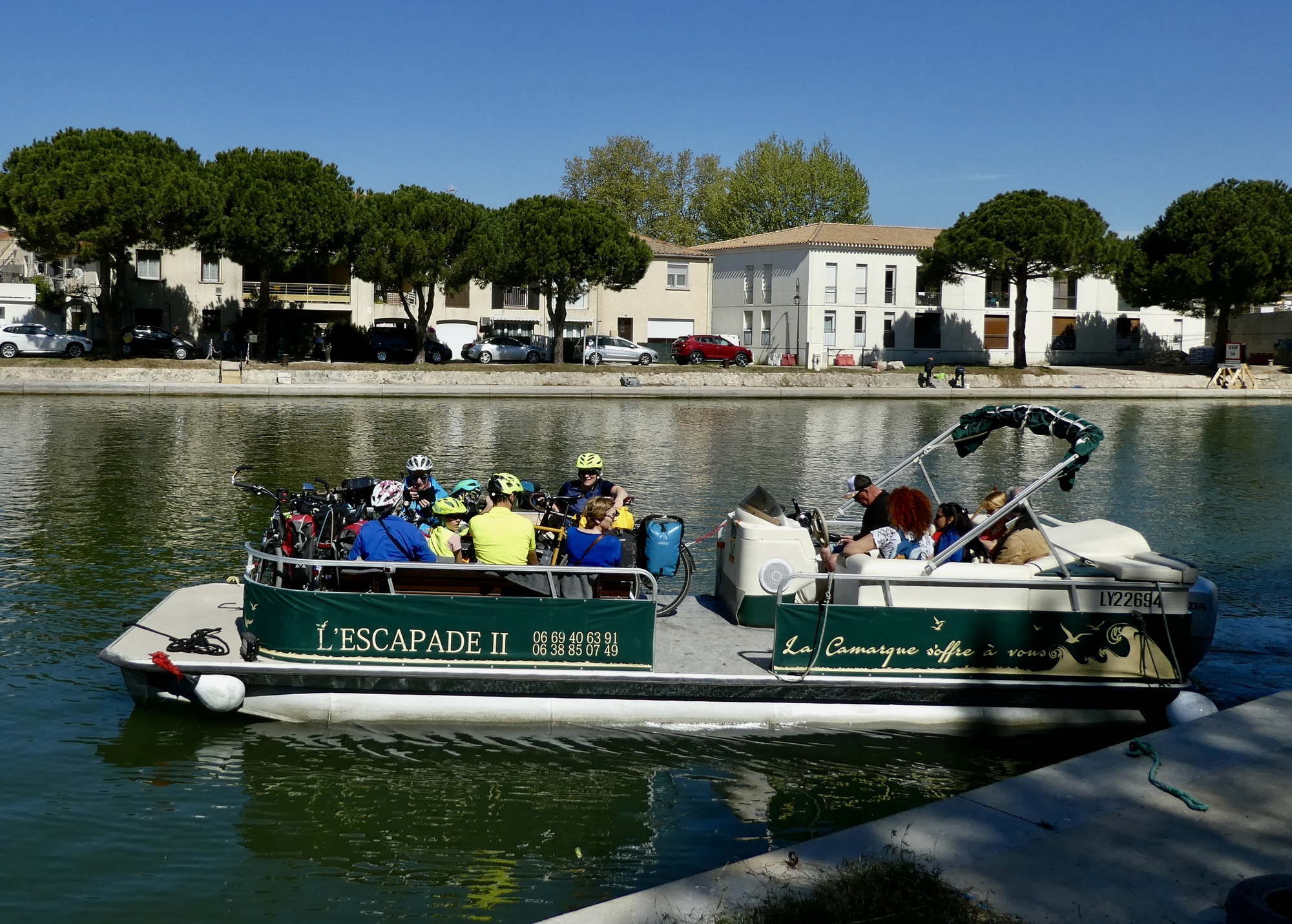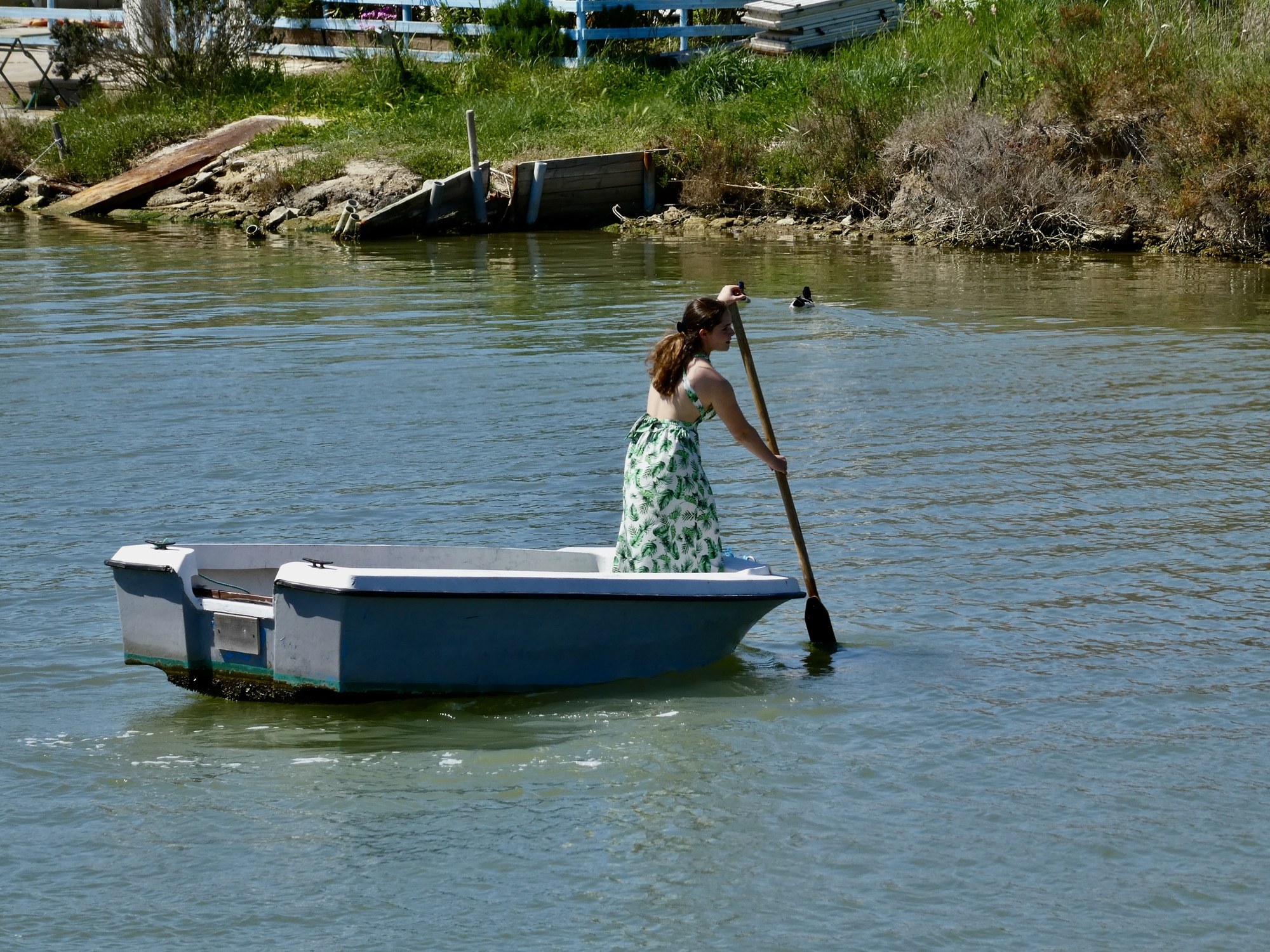April 16, 2022
The Petit-Camargue
An incredible summery day today. 60 when we awaken, clear skies, a project high of 80. No fans of hot-weather biking, we get an early start so we can get most of the ride in before it gets uncomfortably warm. On top of that, it’s windy and expected to become more so as the day wears on.
We’re out the door by 9, and within a mile are out in the country biking past vineyards, orchards and lavender fields. That’s one of the great things about smaller towns - you don’t waste the first half hour slowly working through city streets and stoplights.
Just three milesinto the ride we come to Marsillargues and stop to admire the pretty scene along the Vidourle - fishermen linking the near bank, a wier, an unusual bridge. We cross it, and we’re in the Petit-Camargue.

| Heart | 4 | Comment | 0 | Link |

| Heart | 6 | Comment | 0 | Link |
Maybe I’ve known what the Petit-Camargue is? I forget what I remember. Just to orient us all then, the Camargue is the broad flat expanse west of Marseilles at the mouth of the Rhone river - one of the widest expanses of flat terrain in France. They grow rice here, harvest salt in pans and lagoons along the shore. White Camargue horses run wild in the large national park that protects much of the delta. Birds migrate through and nest here in the thousands. Many of you are undoubtedly already aware of the Camargue.
The Petit-Camargue though? That takes a little more explanation. Briefly, the Rhone (one of the most important rivers in Western Europe, originating in the high Alps along the Swiss-Italian border) splits at Arles when it nears the Mediterranean. What is now the main channel continues straight south, and the former main channel breaks off and comes to the sea about twenty miles to the west. It’s similar to the Po delta, where the Po splits into four or five large distributaries as it reaches the Adriatic south of Venice.
After the split, the primary course is still known as the Rhone. The smaller split is the Petit-Rhone. The triangular wedge between them is the Camargue. West of the Petit-Rhone the terrain is still similarly flat, and is termed the Petit-Camargue. It’s the wedge between the Petit-Camargue and this river, the Verdourle.
End of the geography tutorial; back to the tour.
If you find your way onto one of the quiet roads or a bike path along a canal, the riding is brilliant - a lot of reward for a small effort. For most of the first half of the ride we’re biking a smooth asphalt bike path alongside the Rhone-Sete canal, a littoral waterway that eventually connects up to the Canal-du-Midi. Travel by river barge between the Rhone valley and the Atlantic coast at Bordeaux is possible.

| Heart | 3 | Comment | 0 | Link |

| Heart | 3 | Comment | 0 | Link |

| Heart | 3 | Comment | 4 | Link |
2 years ago
No filter, but it’s a fraud. I shoot everything with essentially a point and shoot, invariably using its autofocus function because it’s smarter than I am. Afterwards though I load the photos to the iPad and use its editor to crop and adjust the exposure and contrast to highlight the primary subject. It will definitely intensify the sky, but that’s not really the intent.
2 years ago
2 years ago
A few miles from Aigues-Mortes, our route crosses over to the south bank of the Rhone-Sete canal. We’re immediately met with a road closure warning, but since it’s only two miles to town we decide to continue on. We’re just out for a ride anyway, and if we can’t get through we can always just backtrack and either find an alternate route through or just return to the hotel.
When we make it to Aigues-Mortes it’s clear that the road really is closed, to all forms of land traffic. The bridge ahead is closed for a major construction project, and we’re at the point of a pencil with canals on both sides. Turn back we assume, until a pedestrian tells us to continue on around the next corner. There’s a small foot ferry, with the boat on our side just about to cross and still having room for us, and about 20 bikes and bikers queued up on the opposite bank.

| Heart | 6 | Comment | 0 | Link |
Aigues-Mortes is a fascinating little fortified city, it’s walls completely intact still. We stayed here five years ago and plan on staying here again this autumn, so for now we’re just passing through. Once on the other side, we’re biking along the Rhône-Sete canal again, admiring the great proliferation of waterfowl - we pass literally thousands of flamingos in the coming miles.

| Heart | 0 | Comment | 0 | Link |

| Heart | 3 | Comment | 0 | Link |

| Heart | 0 | Comment | 0 | Link |

| Heart | 4 | Comment | 0 | Link |
I was looking forward to biking along the sea one last time before heading north, but it’s a madhouse when we arrive at beautiful but very touristy Le Grau-du-Roi. It’s Easter weekend, and everyone has the same idea. There are spots we have to walk our bikes through the crowds, and thoughts of a seaside break at a nice cafe are scrapped because every eatery is packed, teeming with tourists. It’s like this for the next four miles, to Le Grande-Motte, where we finally leave the sea and turn northeast toward Lunel.

| Heart | 5 | Comment | 0 | Link |
The ride back, much of it along the canal again, is enjoyable if not quite up to the standard of the first half of the day. It’s hot now and the wind is in our faces, so we’re happy when we return to our hotel and get back in the shade.
There’s more to say, but I won’t. Rachael is upstairs chafing to hit the road before the day gets too hot, so we’ll stop here and leave you with a few more picks and this video that reflects how we’re feeling with most of our recent troubles suddenly behind us. See you tomorrow.
Video sound track: Everything’s Coming up Roses, by Ethel Merman

| Heart | 2 | Comment | 0 | Link |

| Heart | 1 | Comment | 0 | Link |
Ride stats today: 43 miles, 800’; for the tour: 783 miles, 39,600’
Today's ride: 43 miles (69 km)
Total: 783 miles (1,260 km)
| Rate this entry's writing | Heart | 11 |
| Comment on this entry | Comment | 0 |








